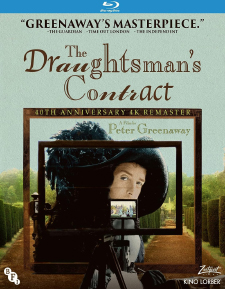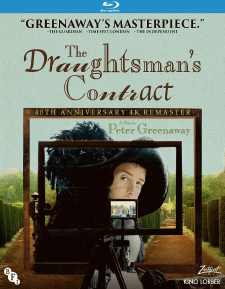Draughtsman’s Contract, The (Blu-ray Review)

Director
Peter GreenawayRelease Date(s)
1982 (June 13, 2023)Studio(s)
BFI/Channel Four/Artificial Eye (Zeitgeist Films/Kino Lorber)- Film/Program Grade: A-
- Video Grade: A-
- Audio Grade: B+
- Extras Grade: A-
Review
The Draughtsman’s Contract was writer/director Peter Greenaway’s first narrative feature film, and in some regards it remains one of his most accessible works. It’s neither a simple nor a straightforward experience, but it does require less active involvement on the part of the viewer in order to be comprehended at the most basic of levels. Yet there’s a world of difference between understanding and real appreciation. Like the rest of Greenaway’s filmography, The Draughtsman’s Contract rewards those who are willing to expend the effort to delve into all of its mysteries. Aside from the myriad references and allusions that Greenaway includes in his films, The Draughtsman’s Contract is structured as a puzzle box. The clues to solve the puzzle are visible throughout, but it’s challenging to piece them together before it’s too late. That’s fitting, since the viewer ends up sharing the same experience as the central character. His own superficial understanding of what he’s seeing means that he fails to grasp the role that he’s been chosen to play until the rest of the pieces have already fallen into place.
The Draughtsman’s Contract is set in 1694 at a country estate in England. R. Neville (Anthony Higgins) is an arrogant but naïve young artist who has been contracted by the lady of the house, Mrs. Virginia Herbert (Janet Suzman), in order to do a series of 12 drawings of the home and its grounds as a gift for her absent husband. Or at least, that’s her stated reasons, and Neville’s terms for the contract seem somewhat onerous: one sexual encounter with her per drawing. She still complies, despite some obvious distaste for the proceedings, and Neville become an active irritant for many other members of the household including her son-in-law (Hugh Fraser). Meanwhile, her daughter (Anne-Louise Lambert) ends up coercing Neville into a second contract with quite different terms, in this case requiring him to comply with her own sexual whims. While shifting back and forth between these two liaisons, Neville works to complete the drawings, constantly frustrated by inadvertent details in the scenery that don’t seem to belong. By the time that he finally grasps that those details are clues to a scheme that’s been happening behind the scenes, he’s already become an unwitting part of the plot.
Greenaway has stated that one of his central concerns in The Draughtsman’s Contract is the conflict between representation and abstraction; in other words, does the artist reproduce what he sees, or what he knows and/or feels? In Neville’s case, he struggles to find a balance between the two extremes. He insists on absolute control over each tableau that he draws, specifying exactly what’s allowed to be present while he’s drawing. Yet he also insists on stringent accuracy, so he utilizes an Alberti’s Frame in order to achieve it. (An Alberti’s Frame or Alberti’s Veil is a drawing machine that consists of a box with a grid of lines running through it in order to help maintain correct perspective.) When he starts to lose control over some unexpected elements that enter these tableaus, he feels compelled to reproduce them despite the fact that they don’t belong with what he had originally planned. The problem is that he’s not paying enough attention to what’s happening outside of his own frame, so he only sees those parts instead of how they link together to form a whole. That’s why he also fails to see his own part in the grand scheme that they represent—he’s too limited in both his personal and his professional points-of-view.
Frames are of the utmost importance in The Draughtsman’s Contract, on every possible level. Greenaway is of course an accomplished artist as well as a filmmaker, and it’s his own hands that are visible on screen during the drawing sequences. He has always exercised a rigorous level of control over every millimeter of every frame in his films, and unlike Neville, he knows exactly what each part represents and why. Yet he still uses the film frame to limit the perspective of the audience, forcing viewers to do the work of connecting the dots between the constituent parts. He also withheld information through the editorial process. His first cut of The Draughtsman’s Contract ran about three-and-a-half hours long, and in reducing various sublots to bring it down to 108 minutes, he deliberately made the film more inscrutable—not necessarily impenetrable, but definitely more difficult to decipher.
Of course, there’s another frame that’s of the utmost importance to The Draughtsman’s Contract, and that’s the frame-up that eventually victimizes Neville (and yes, the pun was quite deliberate on Greenaway’s part). The narrowness of the frame of reference in The Draughtsman’s Contract excludes some historical context, but everything that happens is being driven by the politics of gender, property ownership, and the right of inheritance. A woman’s financial position was rather tenuous in 1694, and Neville’s naïveté means that he can’t grasp how he’s being used to provide a bit more security—unfortunately for him, once something has outlived its usefulness, it must be discarded. As usual in Greenaway’s work, it’s all a game: the game Neville thinks that he’s playing with the women, the game that the women are really playing with him, and the games that Greenway loves playing with his audience. As fascinating as the sociopolitical elements of The Draughtsman’s Contract may be, it’s ultimately the latter game that’s the real subject matter of the film. We’re all the willing victims of Greenaway’s delightfully intricate schemes.
Cinematographer Curtis Clark shot The Draughtsman’s Contract on 16 mm film (in Super-16 format) using Aaton LTR cameras with spherical Zeiss Super Speed and Cooke Varokinetal lenses. The negative was blown up to 35 mm for its theatrical release, framed at 1.66:1. Kino Lorber describes this version as having been “newly remastered in 4K by the BFI National Archive,” but there’s no other information available regarding the master. Presumably it’s the same one that the BFI used for their own Blu-ray release in 2022, and it definitely appears to have utilized a scan from the original 16mm camera negative, not from any of the blowups. The image is clean and undamaged, with nary a speck to mar it, and everything is as sharp and detailed a 16 mm negative will allow. While a 4K version could possibly offer better grain management thanks to the greater breathing room on a UHD, the encoding on this Blu-ray is no slouch. The colors look accurate, and the contrast range is solid. There’s little to complain about here.
Audio is offered in English 2.0 mono DTS-HD Master Audio, with optional English SDH subtitles. While it might have been nice to had an alternate track that offered Michael Nyman’s score in stereo, this is the original theatrical mono mix. Everything sounds clean and clear, with no defects of note.
The following extras are included:
- Audio Commentary by Peter Greenaway
- Peter Greenaway Video Introduction (SD – 9:57)
- Peter Greenaway Short Films:
- Intervals (1969) (SD – 6:27)
- Windows (1974) (SD – 3:36)
- Dear Phone (1976) (SD – 16:40)
- Water Wrackets (1978) (SD – 11:19)
- Four Deleted Scenes (SD – 10:15)
- Behind-the-Scenes Footage (SD – 10:27)
- Interview with Michael Nyman (SD – 6:40)
- Re-Release Trailer (HD – 1:33)
Greenaway’s commentary opens with him briefly recounting his early career while explaining how he ended up moving into narrative features, and once that’s out of the way, he dives into the minutiae surrounding The Draughtsman’s Contract. He does discuss the historical context of 1694 and women’s marital property rights, but it’s possible that he’s playing games even in his commentary track. He mentions that he chose that year partly because it was when a Married Women’s Property Act was passed, but I’ve been unable to track down any such act from that year. (There was a Marriage Duty Act, but that just covered taxation on behalf of the crown.) The really significant property acts weren’t passed until the 19th century, but there was a major one that passed in 1964—and it can’t be a coincidence that 1694 is an anagram of 1964. In any event, Greenaway provides a wealth of fascinating information about The Draughtsman’s Contract, like the careful color coding of the costuming to emphasize Neville’s status as an outsider. He also explains why he used such a simple camera style with limited crosscutting: he analogizes it to having no prepositions, just the verbs, adjectives, and adverbs. Greenaway’s commentaries won’t be to everyone’s tastes any more than his films are, but it’s a riveting track for anyone with even a passing interest in the artist.
The Peter Greenaway Video Introduction serves as something of a précis for the commentary, condensing the basic information from it into a scant ten minutes. The Four Deleted Scenes offer fleeting glimpses of what was left out from the full three-and-a-half hour cut of the film: Chair, Watercress, Misadventure, and Rain. The Behind the Scenes Footage shows Greenaway and his crew planning, setting up, and shooting a sequence from the film. It’s followed by roughly five minutes of on-set interviews with Greenaway, Janet Suzman, and Anthony Higgins. The Interview with Michael Nyman is part of a Q&A that took place after a screening of The Draughtsman’s Contract at the National Film Theatre, moderated by David Thompson. Nyman explains how his early career as a musicologist helped him to deconstruct the music of Henry Purcell in order to construct his score for the film.
Finally, the Peter Greenaway Short Films are a sampling of shorts that he completed between 1969 and 1978. Intervals is an experimental portrait of the streets of Venice, with the editing, sound effects, and narration working together to from a piece of visual music despite the fact that there’s no actual score. Individual sections are repeated with variations, just like musical phrases. Windows is an amusingly macabre piece, showing a series of peaceful views out of the windows of a country home, accompanied by voiceover narration from Greenaway recounting the ways that 37 different people fell to their deaths from windows. Dear Phone expands on that idea, with Greenaway relating 13 different tales of misadventures involving telephones, interspersed with images of red telephone booths having adventures of their own. Water Wrackets moves everything into the fantastical, displaying natural landscapes of lakes and streams while telling the story of the battles fought by the fictitious Water Wrackets Army.
It’s a fine set of extras, but it is missing two featurettes that were on the 2022 Region B Blu-ray release from the BFI in the UK, Visions: A Film Comment by Angela Carter and The Greenaway Alphabet, plus the Greenway shorts H is for House, A Walk Through H: The Reincarnation of an Ornithologist, and Insight: Zandra Rhodes. (On the other hand, BFI’s set didn’t include the four shorts that are offered here). There’s also a 2019 Region B Blu-ray from Arthaus in Germany that added yet another Greenaway short, Vertical Features Remake. The BFI set may have the overall edge in terms of extras, but this is still a great package, and it’s the only way to get a Region A version of the film. Regardless of which edition that you choose, The Draughtsman’s Contract is an essential purchase for fans of Peter Greenaway, and it’s one of the best options for anyone who wants a reasonably gentle introduction to the work of the master gamesman. Just be forewarned that you may end up opening Pandora’s Box.
- Stephen Bjork
(You can follow Stephen on social media at these links: Twitter and Facebook.)

